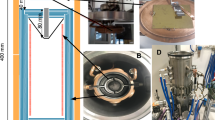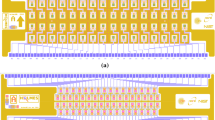Abstract
The HOLMES experiment aims to directly measure the \(\nu\) mass studying the \(^{163}\)Ho electron capture decay spectrum developing arrays of TES-based microcalorimeters implanted with O(300 Bq/detector) Ho atoms. The embedding of the source inside detectors is a crucial step of the experiment. Because the \(^{163}\)Ho production process (neutron irradiation of a \(^{162}\)Er sample) is not perfectly free from impurities, Ho source must be separated from a lot of contaminants. A chemical processing removes every species other than Ho, but it is not sufficient to remove all isotope-related background sources: Indeed, \(^{166m}\)Ho beta decay can produce fake signal in the region of interest. For this reason, a dedicated implantation system was set up. It is designed to achieve the separation power better than 5\(\sigma\) at 163/166 a.m.u. allowing an efficient Ho ions implantation inside microcalorimeter absorbers. Its main components are a 50 kV sputter-based ion source, a magnetic dipole and a target chamber. A specially designed co-evaporation system was designed to “grow” the gold microcalorimeter absorber during the implantation process, increasing the maximum achievable activity which can be implanted. The machine performances were evaluated by means of calibration runs using \(^{63}\)Cu/\(^{65}\)Cu and Mo beams. A special care was given to the study of the more effective way to populate source plasma with Ho ions obtained from different Ho compounds by sputtering process. In this work, the machine development and commissioning are described.






Similar content being viewed by others
Data Availability Statement
The data supporting the findings of this study are available from the authors on request.
References
M. De Gerone et al. J. Low Temp. Phys. This Special Issue (2021)
A. De Rujula, M. Lusignoli, Phys. Lett. B 118, 429 (1982)
A. Nucciotti et al., HOLMES Collaboration. Eur. Phys. J. C 75, 112 (2015)
S. Heinitz et al., PLoS ONE 13(8): e0200910
https://www.aps.anl.gov/Accelerator-Operations-Physics/Software#elegant
W. Parker, R. Falk, Nucl. Instr. Methods 16, 355 (1962)
Acknowledgements
This work was supported by the European Research Council (FP7/2007-2013), under Grant Agreement HOLMES No. 340321, and by the INFN Astroparticle Physics Commission 2 (CSN2). We also acknowledge the support from the NIST Innovations in Measurement Science program for the TES detector development.
Author information
Authors and Affiliations
Corresponding author
Additional information
Publisher's Note
Springer Nature remains neutral with regard to jurisdictional claims in published maps and institutional affiliations.
Rights and permissions
About this article
Cite this article
De Gerone, M., Bevilacqua, A., Biasotti, M. et al. Commissioning of the Ion Implanter for the HOLMES Experiment. J Low Temp Phys 209, 1135–1142 (2022). https://doi.org/10.1007/s10909-022-02752-6
Received:
Accepted:
Published:
Issue Date:
DOI: https://doi.org/10.1007/s10909-022-02752-6




